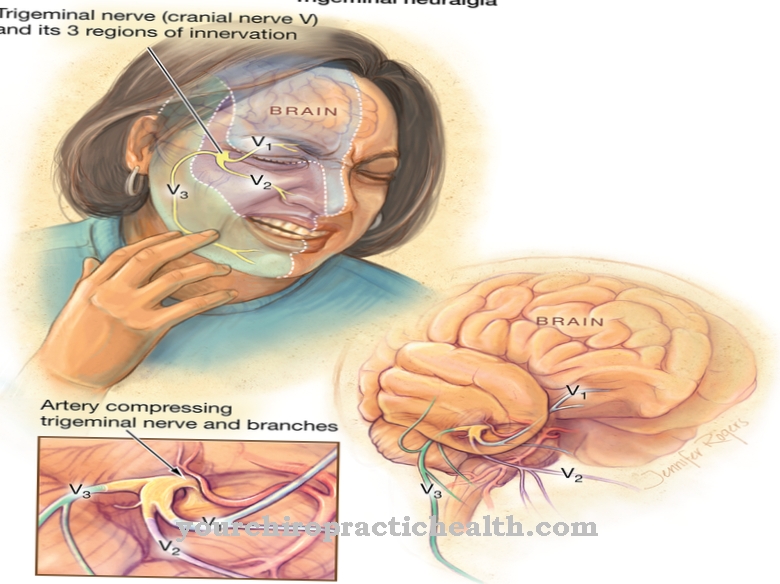Investigations over Alcohol sickness and alcoholism In Germany, there is a certain age group that is most exposed to the risk of alcohol abuse. The results of these studies clearly indicate that the main consumers of alcoholic beverages are between the ages of 18 and 40 years. In this age group, the excessive drinkers are particularly common. At the same time, this means that we will have to reckon with an increasing number of alcoholics in the pathological sense in the coming decades if we do not achieve a change in their behavior towards alcohol in this age group today.
General information about alcoholism
.jpg)
Alcohol can lead to a wide variety of consequences, both acutely and chronically. The liver is particularly affected.
In further analysis of our investigations, it was found that it is mainly single people as well as working and unemployed women and men who are at risk (this is a gender equality trend that we certainly do not want for women). We see time and time again in surveys that people know little about alcohol and alcoholism. This is not surprising, since the majority of doctors themselves know very little about the causes of alcoholism.
Although alcoholic beverages have been consumed for centuries, it was not until the 19th and 20th centuries that scientific research into the problem of alcohol was undertaken without, however, sufficiently clarifying the causes of alcoholism.
The determination of the blood alcohol content - an important prerequisite for the quantitative measurement of the qualitative change in human behavior - was made possible mainly by certain discoveries in the 1920s. However, a specific method, i.e. a method that only determines ethyl alcohol (ethyl alcohol), was developed independently by German and Swedish scientists only in 1951.
This fact means that - strictly scientifically - we did not have a specific method for detecting ethyl alcohol until the 1950s. Today we are able to prove the physiological and increased blood alcohol content with absolute certainty. Yes, we can even determine the concentration of alcohol in the blood that was present during the "time of the crime" by back-calculation, and in this way indirectly determine the degree of influence. Only our current methods of determining the level of drunkenness are accurate and reliable.
However, this gratifying fact is also an indication of the extent to which we still have to stick to the beginnings of other questions of alcoholism - for example, the question, which is fundamental to our society: Why do certain people develop into alcoholics?
The exact proof of alcohol can record the current situation - but not the phase in which someone develops into an alcoholic; nor can he give an answer as to how far this state has already progressed in the persons concerned. We do not want to list the various theories on this question here - emphasize theories - because we do not yet know why and when a person becomes an alcoholic.
Types of alcoholics according to Jellinek
We consider it necessary, however, to briefly sketch at this point the most widely accepted theory of the developmental phases of alcoholism - worked out by E. M. Jellinek. We are convinced that this theory corresponds most to reality and is typical of any alcoholic in some respect.
Problem drinkers (alpha drinkers)
Drinking has a social motive for us. People drink on various social occasions. Not only the future alcoholic notices after a certain period of time that drinking gives him a relief, a relaxation.
At first he is quite right of the opinion that this comes about through the happy mood in society, i.e. through the accompanying circumstances and the ritual of drinking, and less through the consumption of the alcoholic drink itself. (This can be explained by the development of conditioned reflexes, in which all the factors that coincide with a positive reaction sequence in time, after regular repetition, alone cause the entire behavior and sensation sequence.
So - after someone has repeatedly felt relaxation while drinking alcohol in company - alcohol alone can also trigger relaxation in him.)
Occasional Drinkers (Beta Drinkers)
The casual drinker soon feels the connection between the drink and the relief. He drinks larger quantities than the others, because he needs more and more alcohol in order to induce the feeling of relaxation - which in the beginning was actually partly due to society; that is, his drinking becomes regular. This is the initial phase of alcoholism that flows smoothly into the second, the warning phase. Now people are becoming aware of the fact that they drink differently than their fellow citizens and that they need larger amounts of alcohol to induce relaxation. He found that drinking is not a social issue for him, but a need - he feels guilty.
Addiction drinker (gamma drinker)
A characteristic symptom for the warning phase (addicts) should be the so-called memory gaps; man can no longer remember certain processes that happened while drunk. He fears criticism, is also ashamed and therefore begins to withdraw from his social circle. In this phase he still overlooks his situation and could get out of it if he knew that he is at this stage of development. Unfortunately, most people who believe that drinking can solve their troublesome problems do not suspect that after a few years this stage will smoothly transition into the critical phase of alcoholism.
Loss of control over drinking is characteristic of this phase. If the person in question already has an alcoholic drink, he feels the need to keep drinking - until he is completely drunk. After the first glass he cannot refuse the other glasses; but he can now decide whether to take the first sip at all. So at this stage he is able to live without alcohol for weeks or even months.
After this time, however, he believes that he can satisfy himself with just one sip, and has no idea that the inevitable loss of control over his drinking does not arise from his weak will, but is the result of abuse of his body, a complicated, pathological one Mechanism of pathological reflections that he can no longer control. To get out of this situation, he tries to justify his drunkenness more and more under some pretext. He looks for credible reasons why he had to get drunk in this or that specific case. He needs this justification primarily for himself, then more and more for his surroundings.
Mirror Drinker (Delta Drinker)
His drinking has become widely noticed - society is starting to take an interest in his drinking. That is why he evades society and his family and isolates himself. We have to call this person an alcoholic. He already starts the day with the morning drink, during the day he needs a few maintenance drinks and only drinks himself full in the evening. It is quite clear that this way of life does not allow normal work performance, that he gets into financial and social difficulties and one day sees no way out. And with that begins the final phase of alcoholism: Now he gets drunk while working, for which very small amounts are sufficient, which he used to tolerate without further ado.
The drop in alcohol tolerance is a typical sign of this phase.His lies and self-deception collapse; he is abandoned by family and friends and stands helplessly alone. A cure in the truest sense of the word is only possible here if the person concerned has not touched an alcoholic drink for the rest of his life, because he can never learn to drink moderately in society. As E. M. Jellinek and other scientists after him have shown, the individual phases always last years.
causes
But why one becomes an alcoholic and the other does not, is still unknown today. So far we have not been able to determine in the initial phase whether this person will develop into an alcoholic or not. One fact, however, has been absolutely proven: Without alcohol, there can be no alcoholism. That is why we demand that all people come into contact with alcohol as late as possible - hence the legal provisions that make alcohol consumption impossible or difficult for children and young people.
But medical requirements and legal provisions alone will never be enough to decisively curb alcohol abuse. The fight against alcoholism is a social problem in which everyone must participate. It already starts in the family, in the work group, etc. Perhaps this or that person may be of the opinion that drinking is not that bad after all. How wrong this trivialization is has been shown by the presentation of the developmental phases of alcoholism.
If we have to estimate today that one percent of the population is chronically impaired by alcohol, i.e. belongs to the last phase described, then this is reason enough for all levels of society down to the smallest family circles to review their customs and consider whether it is appropriate to "douse alcohol" at every opportunity.
Symptoms, ailments & signs
An alcoholic illness manifests itself primarily through the behavior of an addict. Affected people have the desire to consume alcohol and then often lose control over their drinking behavior. In addition to these classic signs, there are other physical and psychological symptoms. Externally, the disease is noticeable, among other things, through a reddened and puffy face, bags under the eyes and a coated tongue.
Addicts also suffer from excessive sweating, especially on the hands and face. It can also lead to weight loss and glassy eyes. If those affected do not drink, the hands begin to tremble (tremor) and further withdrawal symptoms occur. Affected people are often irritable and suffer from depressive moods when they do not consume.
Inner restlessness, forgetfulness and a lack of concentration are also typical psychological symptoms. Alcohol can also cause sleep disorders and impotence in those affected. If these complaints appear over a period of several weeks or months and are accompanied by neglect of the environment, dependence can be assumed. As the disease progresses, it manifests itself through severe liver damage and sometimes also through a decrease in physical and mental performance.
Complications
Alcoholism (alcoholism) can have a wide variety of consequences, both acute and chronic. The liver is particularly affected. With chronic alcohol consumption, more fats can accumulate in the liver, resulting in a yellowish, doughy-looking fatty liver that can develop into cirrhosis in the course of the process.
This is mainly characterized by dysfunctional synthesis, fewer proteins are produced for the blood, including the important coagulation factors, which increases the bleeding time. But the blood circulation in the liver is also disturbed. The blood is increasingly directed in bypass circuits. This creates varicose veins in the esophagus, which can burst and lead to profuse internal bleeding.
Hemorrhoids can also be the result. This also disrupts the liver's detoxification function. Toxins increasingly accumulate in the body, especially the dangerous ammonia, which can lead to hepatic encephalopathy. As a result, bacteria can also spread in the blood and thus lead to sepsis.
Furthermore, the brain is also damaged by alcohol consumption, so that it can lead to Korsakoff syndrome. The person concerned no longer has any relation to reality, no longer knows where he is and who he is. Confabulations often appear here, which means that the person concerned is covering up gaps in their memory by spontaneously invented circumstances.
When should you go to the doctor?
As long as there is no psychological or physical dependence on alcohol, the problem can in many cases be overcome by a consistent change in drinking habits without medical help. A doctor visit should be done if the need for alcohol is persistent and alcohol consumption is spiraling out of control.
Physical withdrawal symptoms such as sweating, tremors and insomnia with reduced alcohol consumption or complete abstinence give rise to a medical examination as well as the necessary continuous increase in alcohol intake in order to avoid these symptoms. Talking to a doctor is also advisable if alcoholism dominates large parts of life and other areas such as family, hobbies and work are neglected.
Regular participation in traffic under the influence of alcohol or repeated appearances under the influence of alcohol at work also indicate alcohol addiction, which must be treated with the help of a doctor. The first point of contact is usually the family doctor with whom a trusting relationship already exists:
Depending on the extent of the addiction problem, this person can initiate a referral to a psychologist or an inpatient admission. The liver, stomach, intestines, heart and brain are severely affected by constant excessive alcohol consumption - any symptoms that arise as a result require immediate clarification by a family doctor, internist or neurologist.
Doctors & therapists in your area
Outlook & forecasts
Alcohol disease is a very unhealthy condition for the patient's body and, in the worst case, can also lead to death. In many cases, prolonged consumption of alcohol leads to irreversible damage to the internal organs of the body and also to the brain. Furthermore, the alcohol disease can also lead to psychological complaints. Many of those affected suffer from depression and other psychological complaints.
It is not uncommon for patients to become aggressive under the influence of alcohol and can seriously injure themselves or other people. Life expectancy is significantly restricted and reduced by alcoholism. Those affected also suffer from constant fatigue and exhaustion. The risk of a heart attack also increases enormously.
The treatment of alcoholism can be done by a psychologist or in a closed clinic. In some cases, the person affected can also carry out the treatment themselves. However, it cannot be universally predicted whether this will lead to a positive course of the disease. In many cases, the damage cannot be reversed. This can lead to psychological and neurological restrictions.
Aftercare
In order to ensure the long-term success of a withdrawal therapy, the patient should continue to seek psychological support even after completion. This usually takes place on an outpatient basis in addiction counseling centers or with resident doctors and therapists; an exchange with other affected persons in a self-help group can also be helpful.
The alcoholic is shown ways to solve conflicts and withstand everyday stresses without looking for help in alcohol. If there is a high risk of relapse, temporary accommodation in a special residential facility for addicts may be appropriate. Furthermore, aftercare includes reintegration measures that enable a return to work and social life.
Social isolation and boredom pose a great danger in the dry phase of alcoholism - it is therefore advisable to accept help in structuring the daily routine and for spending free time. Family and friends should support the patient in a fresh start without alcohol and respect his abstinence: under no circumstances should he be encouraged to drink.
In many cases it is necessary to break away from the old circle of acquaintances and build up a new circle of friends - promoting social contacts therefore plays an important role in aftercare. Regular medical examinations are just as important in order to identify and treat organ damage caused by alcohol at an early stage.
You can do that yourself
An alcoholic illness must always be treated under professional supervision. In addition, the typical symptoms of withdrawal can be alleviated with a few home remedies and tricks.
First of all, it is advisable to identify possible triggers for the addictive desire and to eliminate them. A pleasant environment and contact with understanding people are important cornerstones for successful withdrawal. Stress and physical exertion should be avoided if possible in the first few days. Measures such as meditation or light relaxation exercises that support the body and psyche with alcohol withdrawal are more sensible.
With regard to nutrition, the following applies: only low-irritation and low-salt food and little animal fats. The menu should consist of whole grain products rich in fiber, lots of protein, polyunsaturated fatty acids and vitamins A, C and E as well as zinc and thiamine.
In addition, liver-friendly teas made from milk thistle seeds or Heidelberg powder are recommended. Valerian and St. John's wort can also be used due to their calming effect. After consultation with the doctor, light sleeping pills or pain relievers are also recommended, always depending on the severity of the alcoholic illness and the physical condition. In order to avoid complications, all measures should be discussed in advance with the doctor.






.jpg)

















.jpg)



